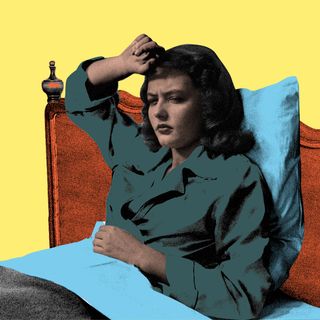
Can We Move On: From the Trope of the Woman Whose Feminism Is Expressed Only Through Smoking, Drinking
The trope draws in progressive audiences through woke-baiting; it appeals to conservatives, too, by making the “woke” female characters ultimately regret their modern views.

In Can We Move On, we revisit old tropes and question whether they have any remaining cultural relevance.
A modern, progressive woman in a Bollywood movie is most likely to smoke, drink, or do both — all while dancing to misogynistic lyrics at dance clubs. Their experiences of leisure are framed as a way to defy gendered culture norms — suggesting, basically, that the best way to resist sanskaar is to ruffle the sexist sensibilities that are undone at the sight of a woman drinking or smoking. Case in point: Swara Bhaskar’s character, Sakshi, in Veere Di Weeding; Kangana Ranaut’s and Priyanka Chopra’s characters, Shonali and Meghna, in Fashion; Deepika Padukone’s character, Veronica, in Cocktail; Kriti Sanon’s character, Bitti, in Bareilly Ki Barfi; Anushka Sharma’s character, Meera, in NH10.
From the traditional woman to the modern woman, subversion happens on full display: the woman is progressive and woke, by way of engaging in an activity intimately associated with men, in the past. “To be very frank about it, showing a woman smoking is a very easy way of showing that she is liberated… A cigarette is mobile, easily available, and overall a simple way to show a woman subverting patriarchy and Anushka Sharma smoking in NH10 reflected just that,” Navdeep Singh, the director of NH10, had said in a statement. The smokes and mirrors around patriarchy are meant to fade away.
However, when movies equate feminism with simply smoking and drinking, and push it under a “wild partying” culture, they manage to dilute the movement and its message. The idea of equity, then, is relegated merely to being an afterthought, drowned in party music.
As Sreeparna Mazumder noted in Vagabomb, “[Smoking and drinking] don’t, in any way, represent the feminist spirit of freedom and equality… Associating smoking and drinking with a woman’s liberation is a wrong idea. These two activities are injurious to health and shouldn’t be romanticized.”
Moreover, smoking and drinking are often considered vices per se — since they are indeed hazardous to health. As such, depicting women indulging in these recreational activities ends up subtly antagonizing the audience against them. Especially so, since Bollywood itself imposes — and cements — negative connotations on smoking, drinking, and partying. Female characters who indulge in these activities are often shown to be self-destructive and unhinged — think Shonali and Meghna in Fashion to Veronica in Cocktail to Mira (played by Parineeti Chopra) in The Girl on the Train.
Related on The Swaddle:
Can We Move On? From the Lady Cop Trope That Shows a Male‑Centric Idea of an Empowered Woman
Moreover, the fact remains that drinking with abandon, or burning through cigarette packs, are not automatic instruments of liberation from misogyny — at least, not in the reality we live in. “When a male actor smokes on screen, it’s simply a habit that is injurious to health. But when a woman does the same, it’s a sign of progression. To be fair, there’s an element of truth to it too. For centuries, women have been restricted from smoking and drinking, activities that only men were permitted to indulge in. But honestly, it’s tiresome to see these clichès being repeated in every other Bollywood film… I am a non-smoker and non-drinker… and I’m a liberal woman,” Mazumder continued.
Therein manifests a tussle between fact and fiction — feminism doesn’t necessarily make one addicted to cigarettes and alcohol; a woman who smokes and drinks doesn’t automatically become a feminist. The very same movies that portray feminism through cigarettes and alcohol often continue to have their “feminist” leads further the extremely unfeminist acts of shaming other women for unfiltered-ly discussing something as natural as childbirth and its complications, being a certain weight, choosing to settle down, or sleeping with their bosses — all things the female leads in Veere Di Wedding indulged in at different points in the movie.
Veere Di Wedding, among other movies, thus presents a rather superficial take on feminism, which becomes even more apparent in its flagship song, Tareefaan. Yes, Bollywood has been treating women as disposable, scantily clad sex objects in movies for years now. The solution, however, isn’t to treat men the same way. Neither does that end misogyny, nor champion feminism — much like making the female leads take up smoking and drinking, doesn’t. Feminism doesn’t seek to take a leaf out of toxic masculinity’s book and unleash the same treatments that have historically been meted out to women, on men. Instead, it seeks to create a more equitable culture — an idea that appears to have been lost on the filmmakers.
In addition, such depictions of the “modern woman” tend to overshadow what the real modern woman can and cannot do. “[U]nlike the cigarette-and-booze-only haze of her cinematic counterpart’s life, the real-life modern Indian girl had aspirations that went far beyond her party habits. She was studying to be more — ‘outshining‘ young boys in board exams, going to college, excelling at work, and trying to solve the eternal problem of balancing employment and home,” Aditi Murti had written in The Swaddle, criticizing Bollywood’s “Modern Girl” trope, which is often showcased through the smoking-drinking clichè.
Having presented the women as progressive, through smoking and drinking, Hindi cinema often designs their characters’ arcs to ultimately apologize for their “modern” lifestyle. The portrayals are, then, designed to be “woke” bait, besides serving to “scare young Indian women back into their positions as dutiful, quiet wives,” as Murti had noted. Take the example of Padukone’s character from Cocktail — she is rejected by the man she loves for her gregarious, independent lifestyle. Veronica should’ve just cut her losses and moved on — given that the impugned boyfriend cheated on her with her best friend, simply because he considered the latter sanskaari enough to get married to. The trash had taken itself out (of Veronica’s life), after all. Yet, for the sake of winning hey boyfriend’s affection, she regrets her modernity and transforms her personality — becoming docile enough for him to like her.
Related on The Swaddle:
Can We Move on? From the Posh Girl Trope That Uses Privilege to Justify Misogyny
As an article from 2021 reads, “The writers of Cocktail pitted Veronica against the benevolent and sanskaari woman Meera (played by Diana Penty) in a way that was meant to result in her loss. Was it a loss, though? Just because she could not marry a ‘desi boy’ who [wouldn’t] grow beyond what he was taught as a child? Not really. The lens of the film constantly shows Veronica as [the] ‘faulty’ one because she does not have the ‘traditional’ Indian values [that] Meera [does].”
This isn’t to say that the modern women on screen must give up smoking and drinking and be depicted as champions of women’s rights, who perfectly balance sanskaar and sexiness — that sexist checklist is a whole other can of worms. Instead, filmmakers can choose not to pack the entirety of their female characters’ feminist values into smoking and drinking, though.
It is possible to show other freeing, subversive ways of women resisting patriarchy in its oppressive entirety — despite incorporating the smoking-and-drinking clichè. Take Lipstick Under My Burkha or Pink, for instance. These movies “work [despite their reliance on the smoking-drinking trope] because [the] women are asserting their individuality in other ways as well. In Pink… they’re strong women, who also party and smoke and do not believe that they should be persecuted because of that. However, to use only the symbol of a woman smoking, or a woman wearing short clothes or partying as a way of portraying her as modern, is just lazy writing,” author Sukanya Venkatraghavan told The Deccan Chronicle in 2017.
The trope, as it currently stands, is quite timid in its stance — trying too hard but too little to appeal to all sections of the audience. For the progressive audiences, this version of modernity — albeit caricatured — is, unfortunately, the only non-regressive representation of women on screen. For the conservatives, the allure of the trope is that it tells a cautionary tale of women who dared to defy the norms society had set for them — only to suffer, and how!
At the end of the day, there is nothing woke about depicting woke-ness in the same template that has perpetuated patriarchy for far too long. So, can we move on?
Devrupa Rakshit is an Associate Editor at The Swaddle. She is a lawyer by education, a poet by accident, a painter by shaukh, and autistic by birth. You can find her on Instagram @devruparakshit.
Related


Is This Normal? “I Can’t Make Myself Go To Bed on Time”
